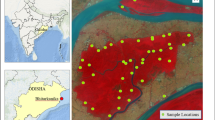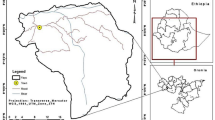Abstract
We present a multivariate regression approach for mapping the spatial distribution of above-ground biomass (AGB) of B. planiculmis using field data and coincident moderate spatial resolution satellite imagery. A total of 232 ground sample plots were used to estimate the biomass distribution in the Nakdong River estuary. Field data were overlain and correlated with digital values from an atmospherically corrected multispectral image (Landsat 8). The AGB distribution was derived using empirical models trained with field-measured AGB data. The final regression model for AGB estimation was composed using the OLI3, OLI4, and OLI7 spectral bands. The Pearson correlation between the observed and predicted biomass was significant (R = 0.84, p < 0.0001). OLI3 made the largest contribution to the final model (relative coefficient value: 53.4%) and revealed a negative relationship with the AGB biomass. The total distribution area of B. planiculmis was 1,922,979 m2. Based on the model estimation, the total AGB had a dry weight (DW) of approximately 298.2 tons. The distribution of high biomass stands (> 200 kg DW/900 m2) constituted approximately 23.91% of the total vegetated area. Our findings suggest the expandability of remotely sensed products to understand the distribution pattern of estuarine plant productivity at the landscape level.
Similar content being viewed by others
References
An SM, Lee JY, Jeong SJ (2006) Seasonal biomass and carbon, nitrogen contents change of Schoenoplectus trigueter in Nakdong river estuary. J Kor Wet Soc 8(3):39–49
Avitabile V, Baccini A, Friedl MA, Schmullius C (2012) Capabilities and limitations of Landsat and land cover data for aboveground woody biomass estimation of Uganda. Remote Sens Environ 117:366–380
Barbier EB, Hacker SD, Kennedy C, Koch EW, Stier AC, Silliman BR (2010) The value of estuarine and coastal ecosystem services. Ecol Monogr 81(2):169–193
Basuki TM, Skidmore AK, Laake PE, van Duren I, Hussin YA (2012) The potential of spectral mixture analysis to improve the estimation accuracy of tropical forest biomass. Geocarto Int 27(4):329–345
Byrd KB, O’Connell JL, Di Tommaso S, Kelly M (2014) Evaluation of sensor types and environmental controls on mapping biomass of coastal marsh emergent vegetation. Remote Sens Environ 149:166–180
Chavez PS (1996) Image-based atmospheric corrections-revised and revisited. Photogramm Eng Rem S 62:1025–1036
Cohen WB, Maiersperger TK, Spies TA, Oetter DR (2001) Modelling forest cover attributes as continuous variables in a regional context with Thematic Mapper data. Int J Remote Sens 22:2279–2310
Efroymson MA (1960) Multiple regression analysis. In: Ralston A, Wilf HS (eds) Mathematical methods for digital computers. Wiley, New York, pp 191–203
Foody GM, Boyd DS, Cutler MEJ (2003) Predictive relations of tropical forest biomass from Landsat TMdata and their transferability between regions. Remote Sens Environ 85(4):463–474. doi: 10.1016/S0034-4257(03)00039-7
Golzarian MR, Frick RA, Rajendran K, Berger B, Roy S, Tester M, Lun DS (2011) Accurate inference of shoot biomass from high-throughput images of cereal plants. Plant Methods 7(1):1–11. doi:10.1186/1746-4811-7-2
Güneralp I, Filippi AM, Randall J (2014) Estimation of floodplain aboveground biomass using multispectral remote sensing and nonparametric modeling. Int J Appl Earth Obs 33:119–126
Hashim M, Misbari S, Yahya NN, Ahmad S, Reba MN, Komatsu T (2014) An approach for quantification of submerged seagrass biomass in shallow turbid coastal waters. In: Geoscience and Remote Sensing Symposium (IGARSS): 2014 IEEE International, Quebec City, Canada, 13–18 Jul, pp 4439–4442
Heiskanen J (2006) Estimating aboveground tree biomass and leaf areaindex in a mountain birch forest using ASTER satellite data. Int J Remote Sens 27(6):1135–1158
Hill VJ, Zimmerman RC, Bissett WP, Dierssen H, Kohler DDR (2014) Evaluating light availability, seagrass biomass, and productivity using hyperspectral airborne remote sensing in Saint Joseph’s Bay, Florida. Estuar Coast 37(6):1467–1489
Hurvich CM, Tsai CL (1989) Regression and time series model selection in small samples. Biometrika 76:297–307
Kim GY, Lee CW, Yoon HS, Joo GJ (2005) Changes of distribution of vascular hydrophytes in the Nakdong River estuary and growth dynamics of Schenoplectus triqueter, waterfowl food plant. Kor J Ecol 28(5):335–345
Kim GY, Kim JY, Ganf GG, Lee CW, Joo GJ (2013) Impact of over-wintering waterfowl on tuberous bulrush (Bolboschoenus planiculmis) in tidal flats. Aquatic Bot 107:17–22
Kim JB, Lee WC, Lee KS, Park JI (2013) Growth dynamics of eelgrass, Zostera marina, in the intertidal zone of Seomjin Estuary, Korea. Ocean Sci J 48(3):239–250
Klaassen M, Nolet BA (2007) The role of herbivorous water birds in aquatic systems through interactions with aquatic macrophytes, with special reference to the Bewick’s Swan–Fennel Pondweed system. Hydrobiologia 584(1):205–213
Klemas V (2013) Remote sensing of coastal wetland biomass: an overview. J Coastal Res 29(5):1016–1028
Li P, Jiang L, Feng Z (2014) Cross-comparison of vegetation indices derived from Landsat-7 Enhanced Thematic Mapper plus (ETM+) and Landsat-8 Operational Land Imager (OLI) sensors. Remote Sens 6(1):310–329
Main-Knorn M, Cohen WB, Kennedy RE, Grodzki W, Pflugmacher D, Griffiths P, Hostert P (2013) Monitoring coniferous forest biomass change using a Landsat trajectory-based approach. Remote Sens Environ 139:277–290
Martin SB, Shaffer GP (2005) Sagittaria biomass partitioning relative to salinity, hydrologic regime, and substrate type: implications for plant distribution patterns in Coastal Louisiana, United States. J Coastal Res 21(1):167–174
Mutanga O, Adam E, Cho MA (2012) High density biomass estimation for wetland vegetation using WorldView-2 imagery and random forest regression algorithm. Int J Appl Earth Obs 18:399–406
Park SR, Kim YK, Kim SH, Lee KS (2013) Nitrogen budget of the eelgrass, Zostera marina in a bay system on the south coast of Korea. Ocean Sci J 48(4):301–310
Phinn S, Roelfsema C, Dekker A, Brando V, Anstee J (2008) Mapping seagrass species, cover and biomass in shallow waters: an assessment of satellite multi-spectral and airborne hyper-spectral imaging systems in Moreton Bay (Australia). Remote Sens Environ 112(8):3413–3425
Propastin P (2012) Modifying geographically weighted regression for estimating aboveground biomass in tropical rainforests by multispectral remote sensing data. Int J Appl Earth Obs 18:82–90
Pu R, Bell S (2013) A protocol for improving mapping and assessing of seagrass abundance along the West Central Coast of Florida using Landsat TMand EO-1 ALI/Hyperion images. ISPRS J Photogramm 83:116–129
Pu R, Bell S, Meyer C (2014) Mapping and assessing seagrass bed changes in Central Florida’s west coast using multitemporal Landsat TMimagery. Estuar Coast Shelf S 149:68–79
Pu R, Bell S, Meyer C, Baggett L, Zhao Y (2012) Mapping and assessing seagrass along the western coast of Florida using Landsat TMand EO-1 ALI/Hyperion imagery. Estuar Coast Shelf S 115:234–245
Roelfsema CM, Lyons M, Kovacs EM, Maxwell P, Saunders MI, Samper-Villarreal J, Phinn SR (2014) Multi-temporal mapping of seagrass cover, species and biomass: a semi-automated object based image analysis approach. Remote Sens Environ 150:172–187
Yang H (2013) The case for being automatic: introducing the automatic linear modeling (LINEAR) procedure in SPSS statistics. MLRV 39(2):27–37
Yi YM, Yeo US, Oh DH, Sung KJ (2011) Annual changes in Scirpus planiculmis and environmental characteristics of the Nakdong River estuary. J Kor Wet Soc 13(3):567–579
Author information
Authors and Affiliations
Corresponding author
Rights and permissions
About this article
Cite this article
Kim, J.Y., Im, RY., Do, Y. et al. Above-ground biomass estimation of tuberous bulrush (Bolboschoenus planiculmis) in mudflats using remotely sensed multispectral image. Ocean Sci. J. 51, 151–158 (2016). https://doi.org/10.1007/s12601-016-0013-0
Received:
Revised:
Accepted:
Published:
Issue Date:
DOI: https://doi.org/10.1007/s12601-016-0013-0




